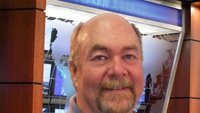Proper HD news set design is essential for local TV stations, says FX Group CEO and creative director Mack McLaughlin

As local stations transition their newscasts from SD to HD, the opportunity to enhance their brand with visually interesting, yet highly functional, news sets might be easy to fumble without an effective plan executed properly.
For more than 20 years, FX Group in Ocoee, FL, has helped stations create their on-screen image with set and lighting design services. In the past few years, much of that effort has been focused on HD.
This week, HD Technology Update spoke with Mack McLaughlin, FX Group CEO and creative director, to learn the essential elements of good HD news set design, the common pitfalls and the right way to design an HD news set.
HD Technology Update: HD's wider aspect ratio and greater resolution seem to demand new news sets if a station is to maximize its return on the investment it’s made to purchase HD studio cameras, lenses, switcher, etc., for an HD newscast. What advice can you offer stations as they consider commissioning a new set for their forthcoming HD newscasts?
Mack McLaughlin: The No. 1 challenge is to design a set that will be shot well in both 16:9 and 4:3 until more households get widescreen televisions. This requires stations to re-think how each shot will work. More care has to be given to how far talent is from each other to prevent one from encroaching in another's shot. A good HD set strikes a balance with existing station preferences and styles with an environment that works in HD. Other challenges include issues of achieving the optimal sense of depth and contrast because HD cameras tend to "flatten" images out.
HDTU: Is a new news set a necessity, or is it worthwhile considering redesigning an existing set for HD?
MM: Getting a new set for your switch to HD is an important move not only because of shot framing and construction quality concerns, but also to show off to your viewers the power of digital television and signal that this truly is a revolutionary change to the way they watch the news.
Get the TV Tech Newsletter
The professional video industry's #1 source for news, trends and product and tech information. Sign up below.
In most cases, remodeling or using an existing set that wasn't designed for HD will be difficult, especially when shooting relationship shots.
A news set is a vital part of building a station's brand. The set also helps boost the newscasts' style, whether it's a fast-paced, high-energy show or a more in-depth broadcast. In addition, features such as rear-projection screens and plasma and DLP monitors not only add a high-tech look to the set, but also are key storytelling tools that allow talent to interact with graphics.
HDTU: Are there any general guidelines you recommend stations follow? If so, what are they? Do these vary depending on market size and budget?
MM: The best recommendation is to start the set design process early. The more time you have to work on the set, the more time designers have to work with you to get the set exactly where you want it. Advanced set planning also makes coordinating the integration of equipment and graphics much easier and allows you to view your conversion project as a whole, rather than separate, compartmentalized pieces, which ultimately results in streamlined, eye-catching and brand-centric broadcasts that draw in viewers.
HDTU: At a recent seminar on HD, a station manager joked that the first people at his door following the announcement that the news would be done in HD were the news talent. They were concerned with what the higher resolution camera might reveal. Given that television is all about images, what steps can you recommend to protect the appearance of talent without softening the appearance of the set? What role does lighting play here? What is your opinion about the use of HD camera settings designed to reduce flaws?
MM: Lighting is absolutely crucial for HD. In many cases, lighting plays a bigger role than makeup or camera settings. That's why it's so important to have professionally designed and maintained lighting. We've found that good lighting can make or break a newscast and truly makes HD become 3-D. That said, makeup and camera settings are also aspects that should be examined and adjusted on a case-by-case basis.
We typically recommend key light at 50 to 70ft-candles maximum for HD. Also, using LED chin lights can be very effective, especially on experienced talent. For maximum depth and clarity, shoot for lens aperture of 2.0 to 2.8.
Other tips include gold diffusion filters on experienced talent, using an ND filter on over lit areas until backgrounds diffuse and pulling focus 6in to 18in in front of talent to soften features and diffuse background.
For makeup, go for the natural look. Makeup shouldn't look too made up. It should be clean, color correct and lightweight. Use finer molecule makeup for better coverage, airbrush if you can and remember: heavy makeup absorbs more light. The best way to find the best mix is to rehearse, test and adjust in studio, on camera.
HDTU: What areas of HD news set design typically get overlooked?
MM: Many stations overlook the importance of planning each and every shot on a set. They tend to focus too much on building a set that may look incredible in wide shots or when you're standing in the studio, but doesn't shoot well and does little or nothing to enhance the storytelling.
It's important to remember that the majority of shots in a typical newscast are tight shots; very rarely do viewers see such things as headers or balconies. Another aspect that gets overlooked is lighting, often because installing and, more importantly, maintaining studio lights is a challenge. FX's Lighting Optimization program is a solution for this. It's a complete installation and ongoing maintenance package that can save money as well.
HDTU: Stations will continue to have a significantly large SD audience for the foreseeable future. How does that reality impact what can or should be done with a news set?
MM: Because sets are being shot for both aspect ratios, parts of the set that are shown now will be less or more important once 16:9 becomes standard. For example, the upper portion of sets will show up more in 4:3 but less in widescreen, so you don't want to spend too much money on header elements.
It's also interesting to note that even SD viewers notice an improvement in picture quality. It is also important to remember that while 4:3 SD viewers see less of the picture's sides, this space should still be filled with visually interesting but non-essential scenic or graphic elements. More tips and examples are available in FX's free "HD and Set Design" guide available at www.fxhighdef.com.
HDTU: Is there anything else you'd like to add?
MM: When selecting a set designer, make sure that you look for a company that not only has experience building eye-catching HD sets, but also has the expertise to help educate and guide you during this challenging process. Be sure to review how every shot will look and don't get blinded by a sprawling set that looks great in the studio but doesn't shoot well.
For more information, visit www.fxgroup.tv.
Tell us what you think!
HDTU invites response from our readers. Please submit your comments to editor@broadcastengineering.com. We'll follow up with your comments in an upcoming issue.
